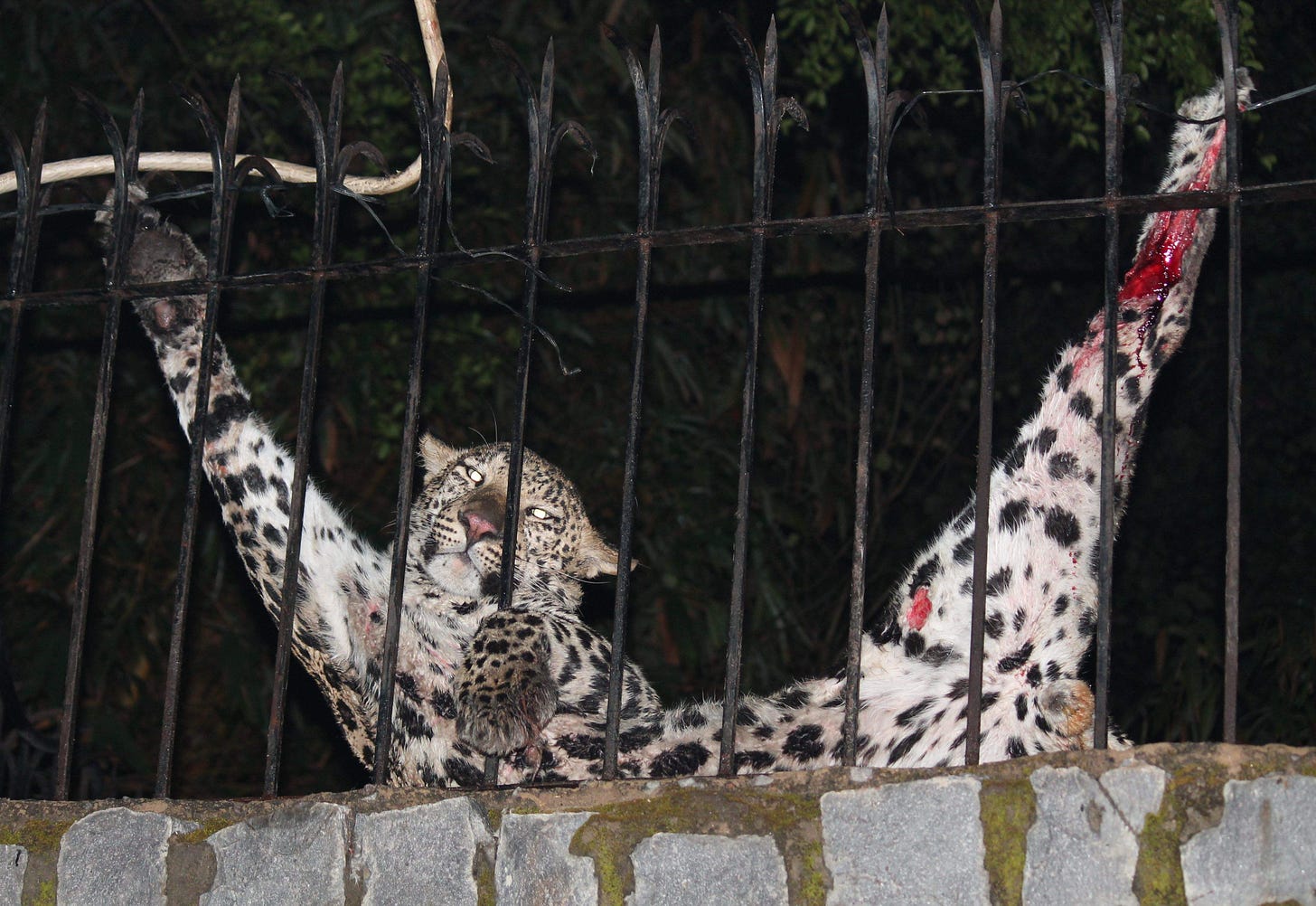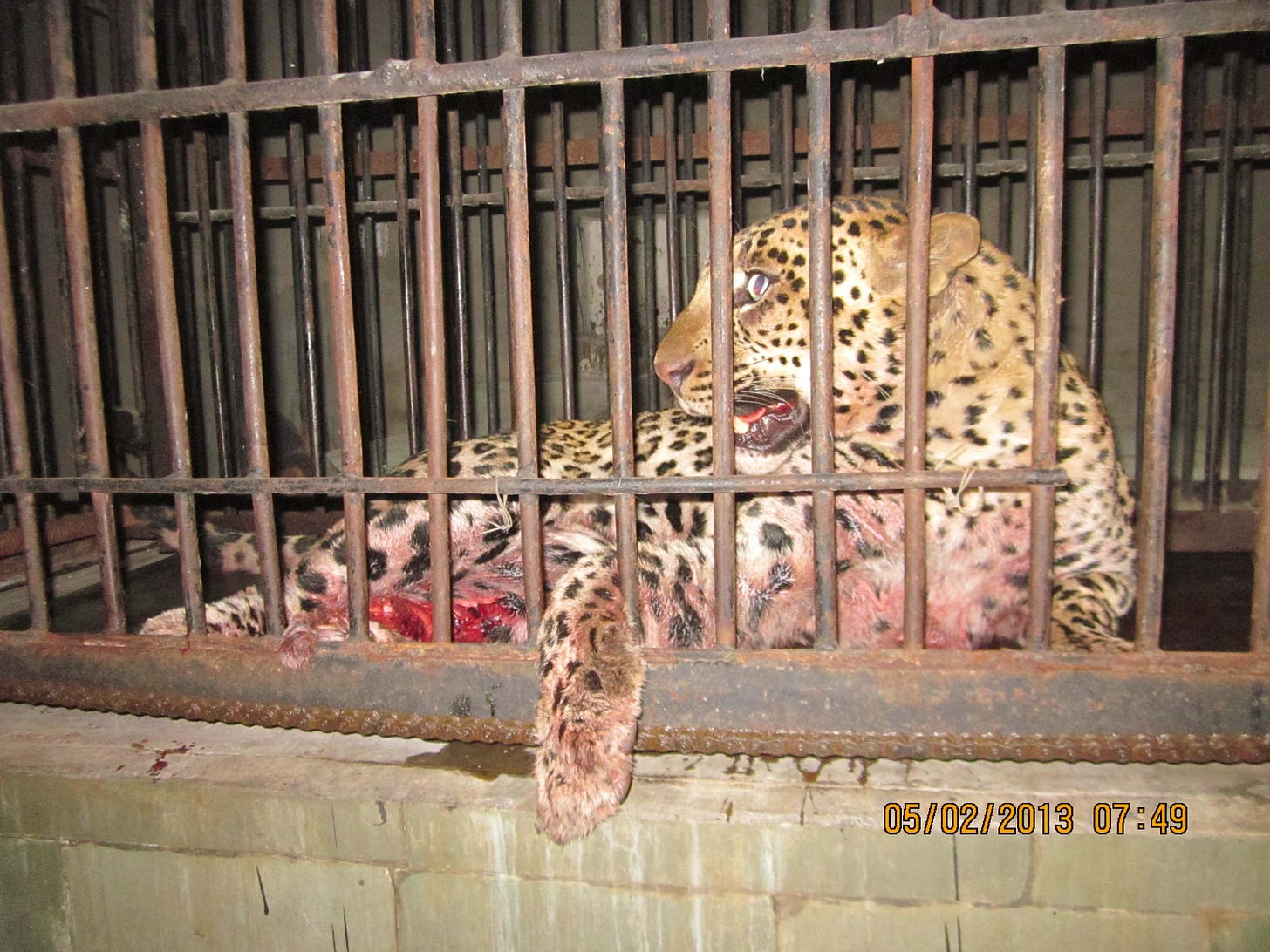By Jordan Schaul | National Geographic | February 15, 2013
Contributing Editor Dr. Jordan Schaul has reported on a recent penetration-induced lesion(s) in a wild adult Indian leopard as conveyed to him by Wildlife SOS colleagues in India. The leopard sustained the penetration trauma wound from impalement on a fence and is presumed to recover. Beware that the photos are graphic.
Last week, in a dramatic and delicate seven-hour-long multi-organizational/agency rescue operation executed by NGO’s Wildlife SOS, Friendicoes SECA, and both the Delhi Police and the Fire Departments, the interagency teams managed to save a severely injured adult Indian leopard near South Delhi’s Chattarpur area.
The wild leopard possibly from the forested Aravalli hills was observed leaping onto a high wall of a farmhouse in Chattarpur DLF farms by a security guard. In an attempt to scale the 15-foot wall surrounding the farmhouse, the cat was impaled on the metal spikes and grill on the top of the wall and was trapped helplessly for an extended period of time. As might be imagined, the animal was perceived to be in excruciating pain from the penetrating trauma induced by the metal spikes.
At 1:30 AM on the 5th of February, the Delhi Police contacted the Wildlife SOS Helpline (9871963535) and a team of rescue and rehab staffers from Wildlife SOS along with a clinician (Dr. Prabhakaran with Friendicoes SECA) were deployed to the trauma scene with rescue equipment for hoisting the animal off the spikes with adequate and appropriate analgesics and anesthetics.
Because the Delhi Zoo was not contactable initially, Wildlife SOS arranged to get a (large feline) transport cage from their rescue center in Gurgaon as deemed necessary for immediate transport once the cat was safely hoisted off the impalement structure. The rescue team worked in the pouring rain to tranquilize the leopard and remove it from a 15-foot high wall and transported the seriously injured cat to the safety of the veterinary hospital at the Delhi Zoo.
“This leopard in south Delhi clearly indicates that there is a serious conflict between humans and leopards in this region. Destruction of their habitat displaces these big cats and they are left with nowhere to go. Delhi Police Officer Lakram Singh was present during the entire operation and we are grateful for the support of the Police,” said Geeta Seshamani, Co-founder of Wildlife SOS
Dr. Prabhakaran of Friendicoes said, “the leopard is very severely injured as the metal spikes have completely impaled the front and rear leg and it is in a serious condition. The bone and the muscles are exposed on the rear leg and the other legs are also injured from the animal struggling in an attempt to escape. The animal is in a grave condition and requires extensive treatment. We have given it tetanus vaccination and painkillers. We hope it recovers and survives.”
The Wildlife SOS and Friendicoes Team transported the rescued leopard along with a Delhi Police vehicle escort to the Delhi Zoo where Dr. Paneerselvam and Range Officer Manoj Kumar coordinated the housing and subsequent care of the leopard in the Veterinary hospital.
The Wildlife SOS Helpline works with the guidance of the Chief Wildlife Warden Delhi and the Delhi Wildlife Dept. to rescue wildlife in distress.
(Unfortunately, I learned late yesterday (2/15) that the leopard did not survive. This was not the first and will likely not be the last impalement of a wild felid under the same circumstances in the same location. It may even happen sooner than later as these highly adaptable big cats try to survive human population growth, continued encroachment on habitat outside of protected areas, and other threats to their wild lifestyles. Leopards are somewhat of an anomaly among large carnivores in regard to their ability to coexist with people, but wild carnivore-human conflict persists and this “barometer”/indicator species is telling us that the news for vanishing species is worsening, no doubt. -JCS)
ABOUT NATIONAL GEOGRAPHIC SOCIETY
The National Geographic Society is a global nonprofit organization that uses the power of science, exploration, education and storytelling to illuminate and protect the wonder of our world. Since 1888, National Geographic has pushed the boundaries of exploration, investing in bold people and transformative ideas, providing more than 14,000 grants for work across all seven continents, reaching 3 million students each year through education offerings, and engaging audiences around the globe through signature experiences, stories and content. To learn more, visit www.nationalgeographic.org or follow us on Instagram, Twitter and Facebook.
MEET THE AUTHOR
With training in wildlife ecology, conservation medicine, and comparative psychology, Dr. Schaul's contributions to Nat Geo Voices have covered a range of environmental and social topics. He draws particular attention to the plight of imperiled species highlighting issues at the juncture or nexus of sorta situ wildlife conservation and applied animal welfare. Sorta situ conservation practices are comprised of scientific management and stewardship of animal populations ex situ (in captivity / 'in human care') and in situ (free-ranging / 'in nature'). He also has a background in behavior management and training of companion animals and captive wildlife and conservation marketing and digital publicity. Jordan has shared interviews with colleagues and public figures, as well as editorial news content. In addition, he has posted narratives describing his own work, which include the following examples: • Restoration of wood bison to the Interior of Alaska (As Animal Curator at Alaska Wildlife Conservation Center and courtesy professor at the University of Alaska) • Rehabilitation of orphaned sloth bears exploited for tourists in South Asia (As executive consultant 'in-residence' at the Agra Bear Rescue Center managed by Wildlife SOS) • Censusing small wild cat (e.g. ocelot and margay) populations in the montane cloud forests of Costa Rica for popular publications with 'The Cat Whisperer' Mieshelle Nagelschneider • Evaluating the impact of ecotourism on marine mammal population stability and welfare off the coast of Mexico's Sea of Cortez (With Boston University's marine science program) Jordan was a director on boards of non-profit wildlife conservation organizations serving nations in Africa, North and South America and Southeast Asia. He is also a consultant to a human-wildlife conflict mitigation organization in the Pacific Northwest. Following animal curatorships in Alaska and California, he served as a charter board member of a zoo advocacy and outreach organization and later as its executive director. Jordan was a member of the Communication and Education Commission of the International Union for the Conservation of Nature (CEC-IUCN) and the Bear Specialist Group of the IUCN Species Survival Commission (BSG-SSC-IUCN). He has served on the advisory council of the National Wildlife Humane Society and in service to the Bear Taxon Advisory Group of the Association of Zoos and Aquariums (AZA Bear TAG). In addition, he was an ex officio member of the council of the International Association for Bear Research and Management.




